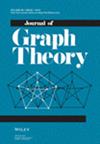Orientations of graphs with maximum Wiener index
IF 0.9
3区 数学
Q2 MATHEMATICS
引用次数: 0
Abstract
In this paper, we study the Wiener index of the orientation of trees and theta-graphs. An orientation of a tree is called no-zig-zag if there is no subpath in which edges change the orientation twice. Knor, Škrekovski, and Tepeh conjectured that every orientation of a tree achieving the maximum Wiener index is no-zig-zag. We disprove this conjecture by constructing a counterexample. Knor, Škrekovski, and Tepeh conjectured that among all orientations of the theta-graph with and , the maximum Wiener index is achieved by the one in which the union of the paths between and forms a directed cycle of length , where and are the vertex of degree 3. We confirm the validity of the conjecture.
具有最大维纳指数的图形方向
本文研究了树和θ图的方向的维纳指数。如果树的一个方向上不存在边改变方向两次的子路径,则称为无之字形方向。Knor、Škrekovski 和 Tepeh 猜想,达到最大维纳指数的树的每个方向都是无之字形。我们通过构建一个反例推翻了这一猜想。Knor、Škrekovski 和 Tepeh 猜想,在有 和 的θ图的所有方向中,达到最大维纳指数的方向是和 之间的路径联合形成长度为 和 的有向循环的方向,其中 和 是阶数为 3 的顶点。
本文章由计算机程序翻译,如有差异,请以英文原文为准。
求助全文
约1分钟内获得全文
求助全文
来源期刊

Journal of Graph Theory
数学-数学
CiteScore
1.60
自引率
22.20%
发文量
130
审稿时长
6-12 weeks
期刊介绍:
The Journal of Graph Theory is devoted to a variety of topics in graph theory, such as structural results about graphs, graph algorithms with theoretical emphasis, and discrete optimization on graphs. The scope of the journal also includes related areas in combinatorics and the interaction of graph theory with other mathematical sciences.
A subscription to the Journal of Graph Theory includes a subscription to the Journal of Combinatorial Designs .
 求助内容:
求助内容: 应助结果提醒方式:
应助结果提醒方式:


